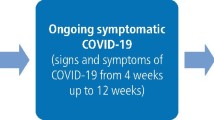Abstract
Data sources Self-developed survey.
Data extraction and synthesis This was a cross-sectional study using a self-administered online survey.
Results Out of 700 randomly selected dentists in Jordan, 368 completed an online survey. Of those, 36% reported that the incubation period for COVID-19 is 1-14 days. The majority were aware of the symptoms of the disease and can identify affected patients. Nonetheless, 36.7% of dentists did not believe it to be a serious public health issue.
Conclusions This group of Jordanian dentists was generally aware of COVID-19 symptoms and mode of transmission. Clinical practice guidelines should be made available to dentists by their associations during such crises.
Similar content being viewed by others
A commentary on
Khader Y, Al Nsour M, Al-Batayneh O et al.
Dentists' Awareness, Perception, and Attitude Regarding COVID-19 and Infection Control: Cross-Sectional Study Among Jordanian Dentists. JMIR Public Health Surveill 2020; 6: e18798. DOI: 10.2196/ 798.

GRADE rating
Commentary
At this time of the COVID-19 global pandemic, the presence of evidence to inform decision making is of paramount importance. Dental organisations, local and international, have a great responsibility toward protecting patients and providers by establishing evidence-based clinical guidelines and protocols. Given that the pandemic has been around for about five months, randomised-controlled trials or long-term observational studies are yet to be conducted. Most of the currently available evidence is either observational of a very short duration or descriptive in nature.

© miljko/E+/Getty Images Plus
An important aspect of these guidelines is the awareness and readiness of providers to deal with issues. Hence, the study at hand attempted to explore awareness, perception, and attitude regarding COVID-19 infection control in dental clinics among a group of Jordanian dentists. An online survey in English was sent to members of five Facebook groups created by members of the Jordan Dental Association. It was not mentioned why the survey was sent via Facebook rather than the official mailing list of the association. From those five groups, 700 were purportedly randomly selected, although the random selection process was not described. The survey comprised closed-ended questions covering the following areas: demographics; awareness of the Covid incubation period; symptoms of the disease; mode of transmission; infection control measures for preventing COVID-19 transmission; perception of the disease; and attitude towards treating patients with COVID-19. The survey was neither validated nor piloted. Descriptive analyses were carried out and means and percentages were used to present data (Table 1). . Out of 700 dentists who were selected for the study, 368 responded (52%) with female dentists representing about 66% of respondents. Of all participants, 44% believed that the Covid 19 incubation period is 7-14 days while 36% believed it to be 1-14 days. The majority believed fever, cough, and shortness of breath to be the most common symptoms (98.6%, 91%, and 86%, respectively). However, dentists believed that touching surfaces is the highest source of disease transmission (93.2%) followed by coughing and sneezing (90%) and handshaking (86%). The vast majority reported that frequent hand washing helps in preventing disease spread. Almost all dentists (97.6%) supported changing masks and gloves for every patient. The majority (71.7%) perceived the disease as very dangerous while only 36.7% believed it is a public health issue. Most of the participants would avoid treating COVID-19 patients (82.6%)if they could. However, half of them said that they would treat the patient, then ask him/her to go to hospital.
The study ends by emphasising that 68% of participating dentists recognised a role for themselves in educating patients and increasing their awareness.
Although this is a typical survey about dentists' knowledge and attitudes regarding a disease that would not, under normal circumstances, draw a lot of attention, the lethality of COVID-19 has increased its importance but unfortunately not a concomitant rise in the quality of evidence available about it.. Nonetheless, this has study shed some light on significant issues. It highlights that it is important at this stage to understand how dentists would react to a COVID-19 patient, especially if presenting with a dental emergency such as pain or a fractured tooth. Until the medical community fully understands the virus's behaviour, common sense dictates that elective dental treatment should be postponed whenever possible to avoid potential spread of the virus. Equally important to understand was dentists' preparedness and awareness about COVID-19 as healthcare providers. Dental organisations should utilise such studies in order to draft policies to ensure the safety of both patients and dental teams.
Author information
Authors and Affiliations
Rights and permissions
About this article
Cite this article
Al-Ansari, A. Dentists thoughts about COVID-19. Evid Based Dent 21, 60–61 (2020). https://doi.org/10.1038/s41432-020-0102-x
Published:
Issue Date:
DOI: https://doi.org/10.1038/s41432-020-0102-x



